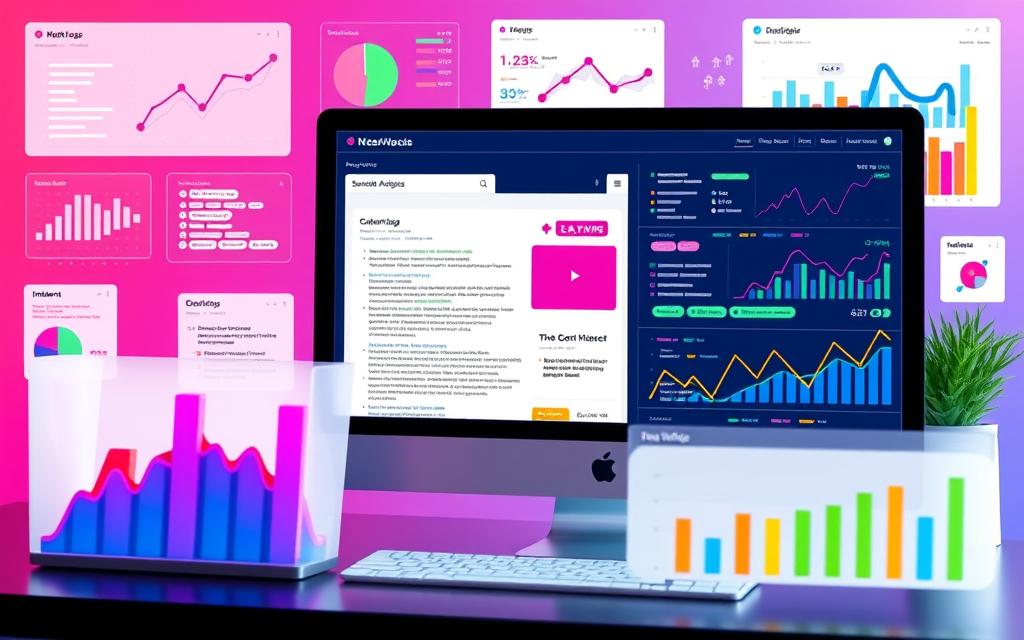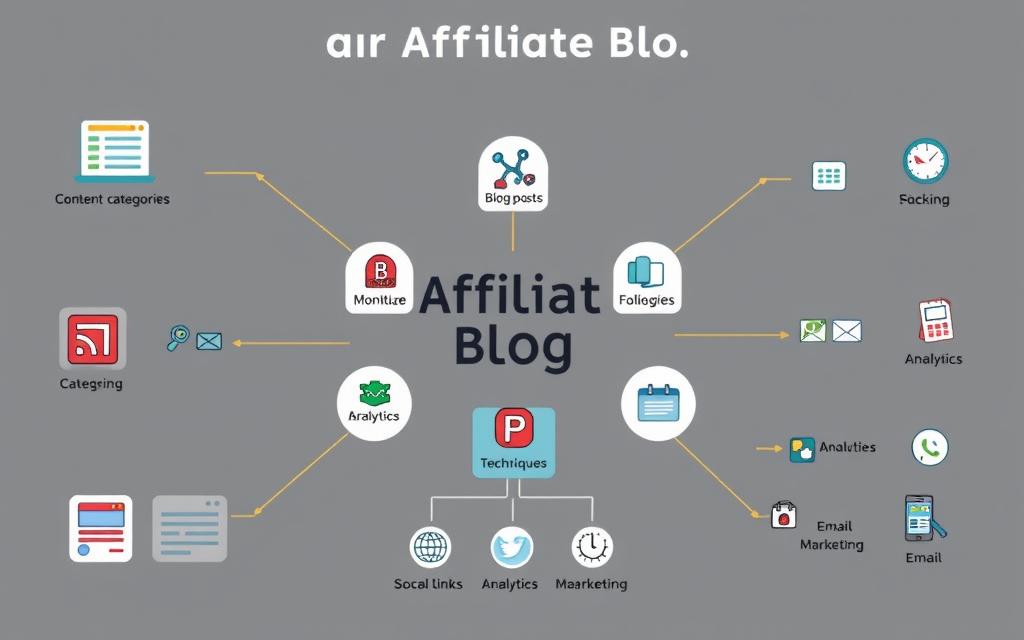Are you new to affiliate marketing and want to create a successful blog? You’re in the right spot. This guide will show you the best tools and strategies for SEO success in your affiliate blog.
Starting or improving your affiliate blog? Knowing SEO is key. With the right SEO, you can get more visitors, be seen more, and earn more from affiliate marketing.
We’ll cover affiliate blogging from the basics to optimizing for search engines. You’ll learn about the best software, creating great content, and SEO. We’ve got everything you need.
Key Takeaways
- Discover the fundamentals of affiliate blogging and why it’s a smart choice for beginners
- Learn about the essential affiliate marketing terms and how the process works
- Explore the top affiliate blog software options and factors to consider when choosing the right platform
- Uncover best practices for crafting engaging blog content and maintaining a consistent publishing schedule
- Dive into the world of SEO, from keyword research to on-page optimization techniques
- Understand the importance of design, usability, and mobile optimization for your affiliate blog
- Discover effective strategies for promoting your affiliate blog and building a loyal following
Introduction to Affiliate Blogging
Affiliate blogging is a smart way to mix creating content with promoting products through links. It’s perfect for blogging tools for newbies because it’s easy to start and can make money passively. We’ll look into what affiliate blogging is and why it’s great for beginners looking at top affiliate blogging solutions.
What is Affiliate Blogging?
Affiliate blogging means making interesting content on a blog and adding links to products or services. If someone clicks on these links and buys something, you get a commission. This way, you can make money from your blog without needing your own products.
Why Affiliate Blogging is a Good Choice for Beginners
- Low startup costs: Starting an affiliate blog is cheap, as you can begin for free or with a small investment.
- Flexibility: You can pick what to write about and what products to promote, letting you follow your interests.
- Potential for passive income: As your blog grows, you can earn money from sales with less effort over time.
- Learning opportunities: Affiliate blogging helps you learn about content creation, SEO, and digital marketing.
By using affiliate marketing and content creation, blogging tools for newbies can start a lasting online business. It’s a low-risk way to make money passively, making it a good choice for new online entrepreneurs.
Understanding Affiliate Marketing Basics
Affiliate marketing is a way for bloggers and content creators to make money. They do this by promoting products or services from other companies. It’s important to know some key terms and how it works.
Key Terms to Know
- Affiliate: An individual or website that promotes a merchant’s products or services and earns a commission on resulting sales.
- Merchant: The company or brand that offers an affiliate program, providing products or services for affiliates to promote.
- Affiliate program: The set of guidelines, tools, and commission structures that a merchant provides to its affiliates.
- Tracking link: A unique URL that identifies the affiliate responsible for a sale or lead generation.
- Commission: The percentage or fixed amount that an affiliate earns for each sale or lead they generate through their unique tracking link.
How Affiliate Marketing Works
The basic process of affiliate marketing involves four key steps:
- A merchant creates an affiliate program and recruits affiliates to promote their products or services.
- Affiliates sign up for the program and obtain unique tracking links to promote the merchant’s offerings.
- Affiliates incorporate these tracking links into their content, such as blog posts, social media posts, or email campaigns.
- When a customer clicks on the affiliate’s tracking link and makes a purchase, the affiliate earns a commission on that sale.
Beginners can use beginner-friendly content management systems like WordPress. They can also use WordPress plugins for affiliates to make their work easier and earn more.
“Affiliate marketing is a win-win-win situation. The merchant wins because they get new customers; the affiliate wins because they get a commission; and the customer wins because they get a great product.” – Shawn Collins, Co-Founder of Affiliate Summit
Selecting the Right Affiliate Blog Software
Choosing the right software for your affiliate blog is key to success. As an aspiring affiliate marketer, you need a platform that meets your needs. It should have the tools and features to boost your blog’s performance. Let’s look at the important factors, top picks for beginners, and the cost.
Factors to Consider
When picking affiliate blog software, keep these points in mind:
- Ease of use: The platform should be easy to use. This lets you focus on creating content, not getting lost in complex interfaces.
- Customization options: Choose software with lots of customization features. This way, you can make your blog look like your brand.
- Scalability: Your blog software should grow with your business. It should handle more traffic and features without problems.
- Integration with affiliate link cloaking tools: It’s important to have tools that protect your affiliate links and track their performance.
Popular Options for Beginners
Several platforms are great for beginners:
- WordPress: This open-source CMS is popular. It has many plugins, themes, and affiliate blog hosting solutions to help you customize your blog.
- Wix: It’s a user-friendly website builder. Its drag-and-drop interface makes it easy for anyone to manage their blog.
- Squarespace: This platform offers design, hosting, and e-commerce tools. It’s a good choice for those wanting a complete solution for their blog.
Cost Considerations
The cost of affiliate blog software varies. Some, like WordPress, are free but offer paid upgrades. Others, like Wix and Squarespace, have subscription plans. Think about your budget, future needs, and potential ROI when choosing software.

Content Creation Essentials
Creating engaging and informative content is key to a successful affiliate blog. You might write product reviews, comparison articles, or educational pieces. Your content should grab your audience’s attention and help them make smart choices.
By using affiliate tracking software, you can see how well your content does. This lets you make smart choices to improve your blog’s impact.
Crafting Engaging Blog Posts
To write great blog posts, know what your audience wants and needs. Do deep research on what you’re promoting. Then, write content that answers their questions.
Add your own experiences, give detailed analysis, and tell stories that grab people’s interest. Your goal is to build trust and offer real value, not just to sell.
The Importance of a Blogging Schedule
Being consistent is vital in affiliate blogging. Posting regularly keeps your readers coming back and tells search engines your site is worth visiting. Plan your posts with a content calendar that fits your audience’s likes.
Use affiliate tracking software to see how your posts do. This helps you improve your strategy and make your blog more effective.
“The secret to creating content that converts is to put your audience first, not your products.”
Incorporating SEO Best Practices
Optimizing your affiliate blog for search engines is key to attracting visitors. By using proven SEO techniques, you can rank higher in search results. This helps you reach your target audience more effectively.
Keyword Research Techniques
Starting with keyword research is essential for SEO success. Look for the best affiliate blog software for beginners and affiliate marketing platforms in your niche. Use tools like Google Keyword Planner, Ahrefs, or SEMrush to find keywords that people are searching for.
On-Page SEO Tips
- Make your page titles and meta descriptions catchy and include your target keywords.
- Use keywords naturally in your blog content, especially in headings and body text.
- Keep your website structure simple and easy to navigate for both users and search engines.
- Optimize images and multimedia by adding alt text and relevant file names.
- Keep your content fresh and updated to stay relevant for your readers.
By using strategic keyword research and on-page SEO, you can make your affiliate blog more visible. This attracts more qualified leads and boosts your revenue through affiliate marketing.
| SEO Technique | Description | Benefits |
|---|---|---|
| Keyword Research | Identifying high-volume, low-competition keywords relevant to your niche and target audience. | Improves content relevance, boosts search engine visibility, and attracts more qualified traffic. |
| On-Page Optimization | Optimizing various elements of your web pages, such as titles, meta descriptions, content, and images. | Enhances the user experience, signals search engines about the relevance and quality of your content, and increases the chances of higher rankings. |
Design and Usability for Affiliate Blogs
Starting out in blogging and affiliate marketing? Your blog’s design and usability are key. A good-looking, easy-to-use blog keeps visitors coming back and boosts sales.
Choosing the Right Layout
Your blog’s layout is the base of your online space. Go for a clean, modern look that’s easy to get around. Choose a design that organizes your content well, so readers can find what they need easily. Use blogging tools for newbies to set up a pro-looking blog fast, without coding skills.
Mobile Optimization
Today, most people use mobile devices to browse the web. Make sure your blog works well on phones and tablets. Use responsive design to make your blog fit any screen size. Pick top affiliate blogging solutions that focus on mobile to improve your blog’s look and feel on all devices.
| Layout Elements | Mobile Optimization Strategies |
|---|---|
|
|

Focus on design and usability to make your affiliate blog stand out. It should look good and offer a great user experience. This can lead to more engagement, better sales, and success in affiliate marketing.
Promoting Your Affiliate Blog
Getting your affiliate blog noticed is crucial. We’ll look at social media and email marketing to help you grow your audience. These strategies can bring more people to your site.
Social Media Strategies
Social media is a great way to connect with people and share your content. Make accounts on Facebook, Twitter, and Instagram. Post often to keep your followers engaged.
Use hashtags, work with influencers, and try ads to reach more people. This can help your blog get noticed.
Building an Email List
Having an email list is key for affiliate marketing success. Offer free stuff like ebooks or discounts to get people to sign up. Use content management systems and WordPress plugins for affiliates to manage your emails.
Consistent promotion is vital for success. Use social media and email marketing to reach your audience. This will help your affiliate blog thrive.
| Social Media Platform | Key Benefits for Affiliate Blogs | Best Practices |
|---|---|---|
| Large user base, targeted advertising options | Post engaging content, join relevant groups, run ads | |
| Real-time engagement, discoverability through hashtags | Share bite-sized content, participate in conversations | |
| Visual appeal, influencer marketing opportunities | Post high-quality images, leverage Instagram Stories |
Tracking Performance and Analytics
Understanding your affiliate blog’s success is key. You need to know how your website performs and what analytics tell you. The right tools and metrics help you improve your content and marketing. Let’s look at the important parts of tracking your blog’s traffic and conversion rates.
Tools for Monitoring Traffic
Knowing your website traffic is vital. It helps you understand your audience and find ways to get better. Tools like Google Analytics and Matomo give you a full view of your blog’s stats. They show pageviews, unique visitors, bounce rates, and more.
These platforms also check if your affiliate blog hosting and affiliate link cloaking tools work well. They make sure you get accurate data and know who’s doing what.
Understanding Conversion Rates
Conversion rates show how well your affiliate marketing works. They track visitors who do something important, like buying something or signing up for a newsletter. Tools like Google Analytics and affiliate link cloaking tools give you deep insights into these rates.
This info helps you see which content and marketing works best. You can then make smart choices to boost your affiliate blog’s success.
| Metric | Description | Importance |
|---|---|---|
| Pageviews | The total number of pages viewed by your website visitors. | Indicates the overall engagement and reach of your affiliate blog. |
| Unique Visitors | The number of individual users who have visited your website. | Provides insights into the size and growth of your target audience. |
| Bounce Rate | The percentage of visitors who leave your website after viewing only one page. | Helps identify areas for improvement in content and user experience. |
| Conversion Rate | The percentage of visitors who take a desired action, such as making a purchase or signing up for a newsletter. | Measures the effectiveness of your affiliate marketing strategies. |
Using the right tools and understanding key metrics helps you make better choices. You can improve your affiliate blog’s content, marketing, and success.
Conclusion and Next Steps
We’ve explored the world of affiliate blogging together. We’ve covered a lot of insights and strategies to help you succeed. Now, you have the knowledge to start your affiliate blogging journey with confidence.
Recap of Key Points
Let’s quickly go over the main points from this guide. We talked about the basics of affiliate blogging. This includes choosing the right software and platforms for your online presence.
We also discussed creating engaging content and using SEO best practices. Plus, we covered designing a user-friendly blog layout that works well on mobile devices.
Furthermore, we talked about promoting your blog on social media and through email marketing. We also mentioned using reliable analytics tools to track your performance. By mastering these key elements, you’re on your way to a thriving affiliate marketing business.
Encouragement for Beginners
If you’re just starting, remember success takes time. Be open to learning and trying new things. Look into different affiliate blog themes and affiliate tracking software to find what works best for you.
Stay persistent and be ready to adapt. Trust in your abilities and focus on providing value to your audience. With each step, you’re getting closer to your affiliate blogging goals.












Leave a Reply